| Listing 1 - 10 of 13 | << page >> |
Sort by
|
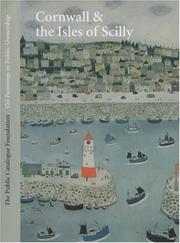
ISBN: 1904931308 Year: 2007 Publisher: London : The Public Catalogue Foundation,
Abstract | Keywords | Export | Availability | Bookmark
 Loading...
Loading...Choose an application
- Reference Manager
- EndNote
- RefWorks (Direct export to RefWorks)
museumcollecties Cornwall. --- museumcollecties Isles of Scilly. --- schilderijen. --- Cornwall. --- Isles of Scilly.
Book
ISBN: 0900278498 Year: 2007 Publisher: Chepstow
Abstract | Keywords | Export | Availability | Bookmark
 Loading...
Loading...Choose an application
- Reference Manager
- EndNote
- RefWorks (Direct export to RefWorks)
BRI British Isles --- United Kingdom ( UK ) --- Monmouthshire --- flora --- distribution maps
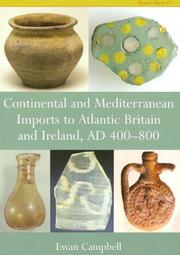
ISBN: 9781902771731 1902771737 Year: 2007 Publisher: London The Council for British Archaeology
Abstract | Keywords | Export | Availability | Bookmark
 Loading...
Loading...Choose an application
- Reference Manager
- EndNote
- RefWorks (Direct export to RefWorks)
Commerce, Prehistoric --- Excavations (Archaeology) --- Iron age --- British Isles --- Antiquities.
Book

ISBN: 9780901158352 0901158356 Year: 2007 Publisher: London : Botanical society of the British Isles (BSBI),
Abstract | Keywords | Export | Availability | Bookmark
 Loading...
Loading...Choose an application
- Reference Manager
- EndNote
- RefWorks (Direct export to RefWorks)
Monocotyledons --- Flore. Botanic determination guides --- Great Britain --- MCO Monocotyledons --- British Isles --- Cyperaceae --- Ireland --- Monocotyledonae --- botanical drawings --- descriptions --- keys --- distribution maps --- Carex --- Classification --- Handbooks
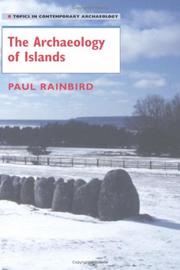
ISBN: 9780521853743 0521853745 0521619610 9780521619615 9780511619007 9780511290572 0511290578 0511287380 9780511287381 0511289979 9780511289972 9780511289385 0511289383 0511619006 1107176530 9781107176539 1280917385 9781280917387 9786610917389 6610917388 0511288700 9780511288708 0511301898 9780511301896 Year: 2007 Volume: *3 Publisher: Cambridge ; New York : Cambridge University Press,
Abstract | Keywords | Export | Availability | Bookmark
 Loading...
Loading...Choose an application
- Reference Manager
- EndNote
- RefWorks (Direct export to RefWorks)
Archaeologists have traditionally considered islands as distinct physical and social entities. In this book, Paul Rainbird discusses the historical construction of this characterization and questions the basis for such an understanding of island archaeology. Through a series of case studies of prehistoric archaeology in the Mediterranean, Pacific, Baltic, and Atlantic seas and oceans, he argues for a decentering of the land in favor of an emphasis on the archaeology of the sea and, ultimately, a new perspective on the making of maritime communities. The archaeology of islands is thus unshackled from approaches that highlight boundedness and isolation, and replaced with a new set of principles - that boundaries are fuzzy, islanders are distinctive in their expectation of contacts with people from over the seas, and that island life can tell us much about maritime communities. Debating islands, thus, brings to the fore issues of identity and community and a concern with Western construction of other peoples.
Island archaeology. --- Islands. --- Maritime anthropology. --- Island archaeology --- Islands --- Maritime anthropology --- Marine anthropology --- Marine ethnology --- Maritime ethnology --- Isles --- Islets --- Anthropology --- Ethnology --- Landforms --- Archaeology --- Social Sciences --- Archeology
Periodical
ISSN: 18346057 18346049 Year: 2007 Publisher: Sydney, Australia : Island Cultures Research Centre, Division of Humanities, Macquarie University,
Abstract | Keywords | Export | Availability | Bookmark
 Loading...
Loading...Choose an application
- Reference Manager
- EndNote
- RefWorks (Direct export to RefWorks)
Island ecology --- Island people --- Islands --- Social life and customs --- Earth Sciences --- Geography --- Island ecology. --- Island people. --- Islands. --- Social life and customs. --- Isles --- Islets --- Island peoples --- Insular ecology --- Ecology --- cultural geography --- island studies --- Landforms --- Ethnology
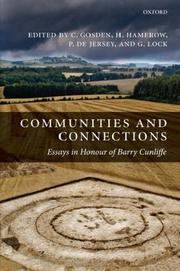
ISBN: 0191917443 1281371416 9786611371418 0191528110 9780191528118 9780199230341 019923034X 9781281371416 6611371419 9780191917448 Year: 2007 Publisher: Oxford ; New York : Oxford University Press,
Abstract | Keywords | Export | Availability | Bookmark
 Loading...
Loading...Choose an application
- Reference Manager
- EndNote
- RefWorks (Direct export to RefWorks)
A collection of essays by many of the leading specialist in the archaeology of the Iron Age and early Roman periods in Britain and western Europe, paying tribute to Professor Sir Barry Cunliffe.
Iron age --- Celts. --- Celtic antiquities. --- Antiquities, Celtic --- Celts --- Antiquities --- Celtic peoples --- Gaels --- Ethnology --- Indo-Europeans --- Alpine race --- Civilization --- British Isles --- Europe --- Islands of the Atlantic --- Antiquities. --- Archaeology --- Archeology --- Anthropology --- Auxiliary sciences of history --- History --- Great Britain
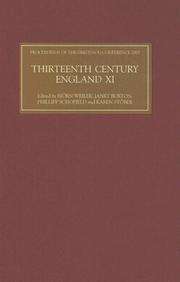
ISBN: 1282150634 9786612150630 1846155991 1843832852 Year: 2007 Publisher: Woodbridge : Boydell & Brewer,
Abstract | Keywords | Export | Availability | Bookmark
 Loading...
Loading...Choose an application
- Reference Manager
- EndNote
- RefWorks (Direct export to RefWorks)
Editors: Janet Burton, BjoÌrn Weiler, Philipp Schofield, Karen StoÌber. The thirteenth century brought the British Isles into ever closer contact with one another, and with medieval Europe as a whole. This international dimension forms a dominant theme of this collection: it features essays on England's relations with the papal court; the adoption of European cultural norms in Scotland; Welsh society and crusading; English landholding in Ireland; and dealings between the kings of England and Navarre. Other papers, on ritual crucifixion, concepts of office and ethcis, and the English royal itinerary, show that the thirteenth century was also a period of profound political and cultural change, witnessing the transformation of legal and economic structures (represented here by case studies of noblewomen and their burial customs; and a prolonged inheritance dispute in Laxton). This volume testifies to the continuing vitality and (with contributors from three continents and six countries) international nature of scholarship on medieval Britain; and moves beyond the Channel to make an important contribution to the history of medieval Europes. Contributors: ROBERT STACEY, FREÌDEÌRIQUE LACHAUD, STEPHEN CHURCH, CHRISTIAN HILLEN, JESSICA NELSON, MATTHEW HAMMOND, KATHRYN HURLOCK, NICHOLAS VINCENT, ADAM DAVIES, HUI LIU, EMMA CAVELL, DAVID CROOK, BETH HARTLAND.
Great Britain --- England --- History. --- History --- HISTORY / Medieval. --- British Isles. --- Crusading. --- England's relations. --- English landholding. --- European cultural norms. --- Inheritance dispute. --- International dimension. --- Kings of England. --- Legal and economic structures. --- Noblewomen. --- Papal court. --- Thirteenth century. --- Welsh society.
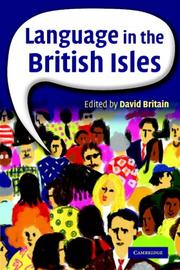
ISBN: 9780521794886 9780521791502 9780511620782 9781107321359 1107321352 0511620780 9781107315969 1107315964 0521791502 0521794889 9781107316911 110731691X 1139809652 1299318703 1107314984 Year: 2007 Publisher: Cambridge [England] : Cambridge University Press,
Abstract | Keywords | Export | Availability | Bookmark
 Loading...
Loading...Choose an application
- Reference Manager
- EndNote
- RefWorks (Direct export to RefWorks)
The British Isles are home to a vast range of different spoken and signed languages and dialects. Language continues to evolve rapidly, in its diversity, in the number and the backgrounds of its speakers, and in the repercussions it has had for political and educational affairs. This book provides a comprehensive survey of the dominant languages and dialects used in the British Isles. Topics covered include the history of English; the relationship between Standard and Non-Standard Englishes; the major non-standard varieties spoken on the islands; and the history of multilingualism; and the educational and planning implications of linguistic diversity in the British Isles. Among the many dialects and languages surveyed by the volume are British Black English, Celtic languages, Chinese, Indian, European migrant languages, British Sign Language, and Anglo-Romani. Clear and accessible in its approach, it will be welcomed by students in sociolinguistics, English language, and dialectology, as well as anyone interested more generally in language within British society.
Sociolinguistics --- English language --- Dialectology --- Great Britain --- Britse eilanden --- Engelse taal --- taalvarianten --- talen --- varianten --- taalvarianten. --- talen. --- varianten. --- Language and languages --- Language and society --- Society and language --- Sociology of language --- Language and culture --- Linguistics --- Sociology --- Integrational linguistics (Oxford school) --- Social aspects --- Sociological aspects --- British Isles --- Languages. --- Arts and Humanities --- Language & Linguistics
Book
ISBN: 9782843100925 2843100925 2377472710 Year: 2007 Volume: *1 Publisher: Grenoble : ELLUG,
Abstract | Keywords | Export | Availability | Bookmark
 Loading...
Loading...Choose an application
- Reference Manager
- EndNote
- RefWorks (Direct export to RefWorks)
Guidé par le fil conducteur de la marche — activité chérie du poète, informant tant sa vie que son œuvre —, cet ouvrage invite le lecteur à un parcours poétique et esthétique qui dessine un paysage socio-culturel en pleine évolution, tout en offrant une perspective originale sur l’une des figures majeures du romantisme anglais. Déambuler avec William Wordsworth dans la nature, le suivre sur les chemins de sa mémoire ou de son écriture — forme de marche intériorisée —, c’est à la fois découvrir l’effervescence de son époque, partager son ouverture émerveillée au monde et revisiter les grands thèmes de son univers poétique : l’imagination, la nature, la mémoire, la mélancolie, la vision, la quête de soi et du passé… Hantés par la figure du marcheur et souvent composés eux-mêmes en marchant, ses vers sont ainsi une invitation à un voyage imaginaire qui conduit finalement aux sources vives de la création et en dévoile quelque peu les mystères.
Walking in literature. --- Marche dans la littérature --- Wordsworth, William, --- Criticism and interpretation. --- Themes, motives. --- Marche dans la littérature --- Literature, British Isles --- Poetry --- ville --- voyage --- mémoire --- paysage --- Alpes --- philosophie --- imagination --- ruralité --- pittoresque --- nature --- histoire des idées --- mélancolie --- marche --- poésie romantique --- marche poétique --- quête de soi --- existentialité --- écriture poétique --- ancrage --- déambulation --- rythme ambulatoire --- rythme amb
| Listing 1 - 10 of 13 | << page >> |
Sort by
|

 Search
Search Feedback
Feedback About UniCat
About UniCat  Help
Help News
News